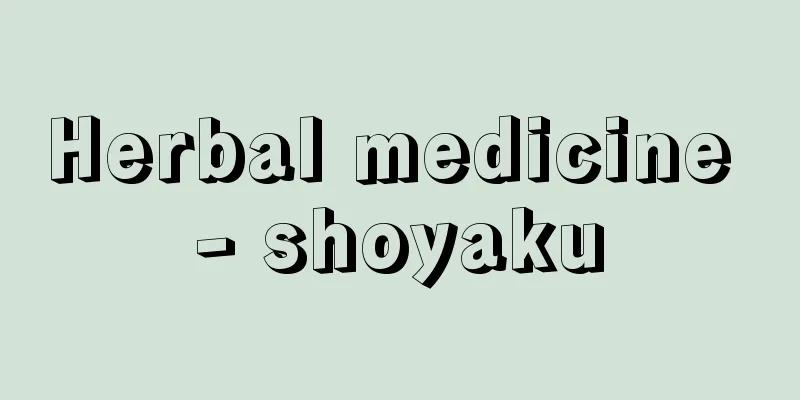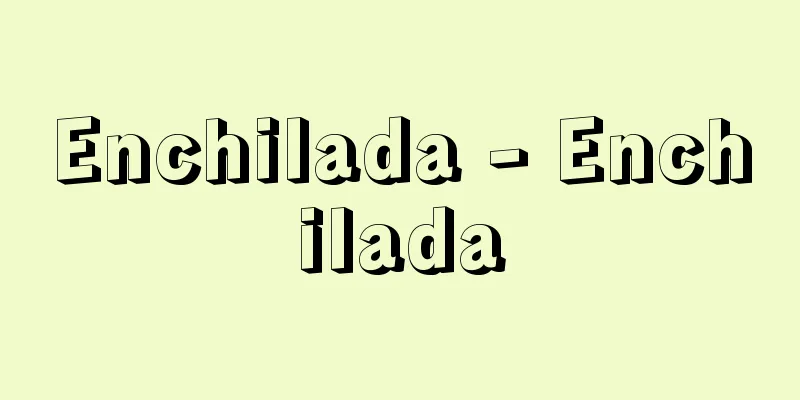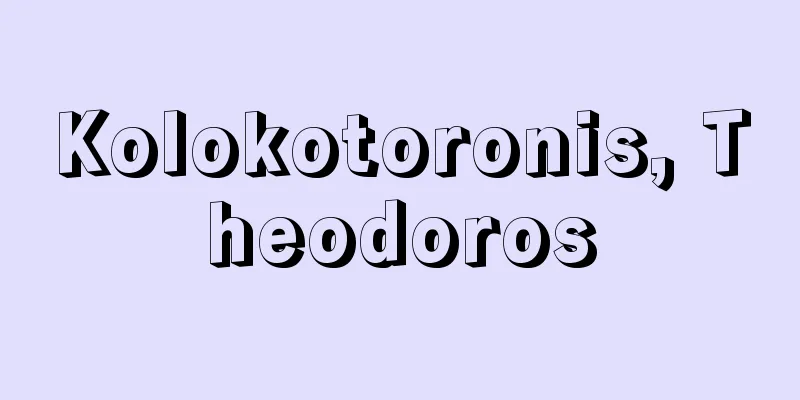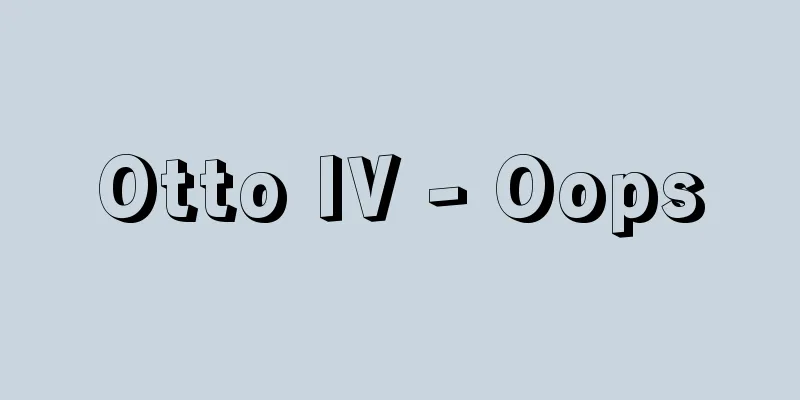Herbal medicine - shoyaku

|
Natural substances that occur in nature and that have, or are used with the belief that they have, some medicinal effect on humans or other animals. Herbal medicines can be broadly divided into three categories: plant herbal medicines, animal herbal medicines, and mineral herbal medicines. [Tsuneo Namba and Masayuki Mikage] Herbal medicineAs they are commonly called, various parts of various plants are used for medicinal purposes. (1) Whole-plant herbal medicines: These are herbal medicines in which the entire plant body or the entire above-ground part is used as a single type of medicine, and there are many different types, with the majority of folk medicines being whole-plant herbal medicines. Generally, plants are collected and used in flower, but occasionally fruits or young plants are used. In traditional Chinese medicine, they are usually dried and used as is, mixed with other herbal medicines, but in Indian medicine they are often used fresh. In folk medicine, they are often used raw, either by taking the juice internally or crushing it for external use. In the case of fungi, the fruiting bodies or underground sclerotia are often used for medicinal purposes, but in some cases, such as the cicada mushrooms, the parasitic hosts are also used. (2) Leafy Herbal Medicines These are herbal medicines in which only the leaves are used medicinally, and are used in the same way as whole-plant herbal medicines, but there are also herbal medicines such as mugwort, which are made by collecting the hairs that grow on the leaves. Some commercially available products often contain stems, branches, or long petioles, but these are considered to be of inferior quality. Sometimes only the petioles are used medicinally. (3) Root and rhizome herbal medicines: The underground parts of the plant are used for medicinal purposes. In plants where the distinction between rhizomes and roots is clear, they are often used separately. In plants where the distinction is not clear, the entire underground part is used. The herbal medicines included here are the most diverse among Chinese herbal medicines, and are often used after being refined (processed). (4) Fruit and Seed Herbal Medicines Mature fruits are generally used for these herbal medicines, but unripe fruits may also be used. In the case of fruits, only the pericarp may be used. Large seeds are usually crushed or cut and then dried before use, but small seeds are boiled as is or powdered before use. In rare cases, the receptacle, calyx, and stalk are used together, and sometimes only the calyx (kaki) or calyx (uri) are used as independent herbal medicines. (5) Flower (light) herbal medicines Generally, the buds or the whole flower that has just started to bloom are used. Special herbal medicines include those that use only the stigma of the pistil (saffron, corn), those that use only the stamen (lotus), and those that use only the pollen (cattail). (6) Cortex herbs: The cortex (outside the cambium) of trees and roots is used for medicinal purposes. Usually, the cork layer is removed before use. (7) Stem Herbs Woody stems and vines are used for medicinal purposes. They are usually used together with the bark, but sometimes only the xylem or only the pith is used alone. (8) Resins: These are the sap and milky liquid that come out when a plant is injured, and are used for medicinal purposes. These include naturally occurring resins, such as pine resin, and artificially obtained resins, such as opium. (9) Extracts of herbal medicines These are aqueous extracts of plants boiled down and usually used after drying, but there are also fluid extracts, which are specifically called liquid extracts. (10) Others: Special objects not included in (9) above, including spines, tendrils, galls, etc. that grow on plants. [Tsuneo Namba and Masayuki Mikage] Animal herbal medicineGenerally, only parts of the body of large animals are used for medicinal purposes, while the whole body of small animals is used for medicinal purposes. In large animals, horns, skin, bones, internal organs, teeth, tongues, reproductive organs, excrement, etc. are used, as well as special parts such as fetuses, placenta, pathologically formed stones, and glue. In the case of insects, the entire body, including adults, larvae, pupas, nests, and shed shells, are used for medicinal purposes, and excrement and wax are sometimes used as well. Seashells and coral are also used for medicinal purposes. Animal herbal medicines are often used as blackened burnt products. [Tsuneo Namba and Masayuki Mikage] Mineral herbal medicineIn addition to rocks, water (rainwater, well water, spring water, etc.), fossilized plants and animals are also used. Special examples include clay from a hearth and lava. When taking it, it can be powdered and taken as is, or it can be boiled. Treatment methods include adding heat or acid. [Tsuneo Namba and Masayuki Mikage] Quality of herbal medicinesUnlike synthetic pure chemical drugs, herbal medicines often contain different compositions of ingredients, even if the drug has the same name, depending on the place of origin and the time of collection. In addition, many herbal medicines have the same name as foreign substances, and some are divided into several grades, so their quality is complicated. Therefore, the correct origin of a herbal medicine must be determined based on the results of current or past market surveys, and further considered from the perspective of pharmacopoeia. In the case of folk medicines, such literature does not exist, making research difficult. In addition, the active ingredients of many herbal medicines have not yet been elucidated, so there are currently many problems with evaluating their quality from the perspective of chemical ingredients. However, vigorous research has been conducted in various fields recently, and it is expected that there will be further developments in this area, along with pharmacological and clinical medical research. [Tsuneo Namba and Masayuki Mikage] "Encyclopedia of Traditional Chinese Medicine and Folk Medicine, by Otsuka Takanori (1966, Shufunotomosha)" ▽ "Medicinal Plants that Changed the World, by N. Taylor, translated and annotated by Namba Tsuneo and Namba Yoko (1972, Sogensha)" ▽ "The World of Medicinal Herbs, by Mitsuhashi Hiroshi (1978, Kodansha)" ▽ "Illustrated Encyclopedia of Japanese and Chinese Medicines in Full Color, Volumes 1 and 2, by Namba Tsuneo (1980, Hoikusha)" ▽ "Japanese and Chinese Pharmacology, edited by Takagi Keijiro et al. (1982, Nanzando)" Source: Shogakukan Encyclopedia Nipponica About Encyclopedia Nipponica Information | Legend |
|
自然界に産する物質のなかで、ヒトあるいは他の動物に対してなんらかの薬効を有するもの、あるいは有するとの考えから使用されているものをいう。生薬は植物性生薬、動物性生薬、鉱物性生薬に3大別することができる。 [難波恒雄・御影雅幸] 植物性生薬俗に草根木皮とよばれているように、いろいろな植物のさまざまな部位が薬用に供される。 (1)全草類生薬 植物体の全体、あるいは地上部全体を1種類の薬物として用いるもので、その種類は非常に多く、とくに民間薬の大半は全草類生薬である。一般に花期のものを採集して用いるが、まれに果実期、あるいは幼少期のものも用いられる。通常、漢方ではそのまま乾燥し、他の生薬と配合して用いられるが、インド医学では新鮮なものも多く利用される。また、民間療法では生(なま)のまま用いられることが多く、絞り汁を内服したり、すりつぶして外用したりすることが多い。 菌類の場合は、子実体、あるいは地下の菌核を薬用として利用することが多いが、なかには、セミタケ類のように寄生宿主をも含めて使用することがある。 (2)葉類(ようるい)生薬 葉のみを薬用とするもので、利用方法は全草類生薬と同様であるが、熟艾(じゅくがい)(もぐさ)のようにヨモギなどの葉に生える毛を集めて利用するものもある。市販品のなかにはしばしば茎や枝、また長い葉柄などの混入するものがあるが、品質的には劣品とされる。なお、ときには葉柄のみが薬用とされる場合もある。 (3)根および根茎類生薬 植物体の地中にある部分を薬用とするもので、根茎と根の区別がはっきりしたものでは、それぞれ単独に用いられることが多い。区別がはっきりしないものは地下部全体が用いられる。これに含まれる生薬は漢薬のなかでも種類が多く、しばしば修治(加工)して用いられる。 (4)果実および種子類生薬 これらの生薬では一般に成熟品が用いられるが、未熟品が使用されることもある。果実の場合は果皮のみの場合もある。また、大形の種子では、通常、破砕あるいは切断したのち、乾燥して用いるが、小形のものでは、そのまま煎(せん)じるか、あるいは粉末化して用いる。まれに花托(かたく)や萼(がく)、果柄があわせて利用されるほか、萼のみ(カキ)、へたのみ(ウリ)が独立した生薬として使用される場合もある。 (5)花類(かるい)生薬 つぼみあるいは咲き始めの花全体を用いるのが一般的である。特殊なものとしては、雌蕊(しずい)(雌しべ)の柱頭のみを用いるもの(サフラン、トウモロコシ)、雄(ゆう)蕊(雄しべ)のみを用いるもの(ハス)、花粉のみを用いるもの(ガマ)などがある。 (6)皮類(ひるい)生薬 樹木や根の皮層部(形成層の外側)を薬用とするもので、通常はコルク層を除去して用いる。 (7)茎類(けいるい)生薬 木質の茎、つるなどを薬用とするもので、通常は皮層とともに用いるが、木部のみ、髄部のみが単独で使用されることもある。 (8)樹脂類生薬 植物体を傷つけたときに出る樹液や乳液を薬用とするもので、松脂(まつやに)のように自然に産するものと、アヘンのように人工的に得るものとがある。 (9)エキス類生薬 植物体の水性エキスを煮つめたもので、通常は乾固して用いるが、流体のものもあり、これはとくに流(りゅう)エキスとよばれる。 (10)その他 (9)までには含まれない特殊なもので、植物体に生じる刺状(しじょう)物、巻きひげ、虫こぶなどが含まれる。 [難波恒雄・御影雅幸] 動物性生薬一般に大形動物の場合は体の一部のみ、小形動物の場合は全体を薬用とする。大形動物では角(つの)、皮、骨、内臓器、歯、舌、生殖器、排泄(はいせつ)物などのほか、特殊なものとしては、胎児、胎盤、病的に生じた結石、膠(にかわ)質などがある。また、昆虫の場合は、成虫、幼虫、蛹(さなぎ)、巣、抜け殻などの全型を薬用とするほか、排泄物やろう質が利用されることもある。そのほか貝殻、サンゴなども薬用とされる。動物性生薬は、しばしば黒焼きとして利用される。 [難波恒雄・御影雅幸] 鉱物性生薬岩石類のほか、水(雨水、井戸水、泉水など)、動植物の化石化したものなどがある。特殊なものに、かまどの土、溶岩などがある。服用に際しては、粉末にしてそのまま服用するか、あるいは煎用される。また、修治法としては熱や酸を加える方法が行われる。 [難波恒雄・御影雅幸] 生薬の品質生薬は、合成された純粋な化学薬品とは異なり、同一名の薬物でもその産地や採集時期などによって、含有される成分組成が異なるのが常である。また、多くの生薬には異物同名品があるほか、いくつかの等級に分けられるものもあるため、その品質は複雑なものとなっている。したがって、生薬の正しい基源については、現在の市場調査、あるいは過去における市場調査の結果などを踏まえたうえで、さらに本草(ほんぞう)学的な考察を加える必要がある。なお、民間薬の場合には、こうした文献が存在していないので、研究は困難となっている。また、多くの生薬においては、その有効成分がまだ解明されていないため、成分化学的に品質を評価することも現段階では問題が多い。しかし、最近は各分野において精力的な研究が進められており、薬理、臨床医学的な研究とあわせて、今後の発展的な成果が期待されている。 [難波恒雄・御影雅幸] 『大塚敬節著『漢方と民間薬百科』(1966・主婦の友社)』▽『N・テーラー著、難波恒雄・難波洋子訳注『世界を変えた薬用植物』(1972・創元社)』▽『三橋博著『生薬の世界』(1978・講談社)』▽『難波恒雄著『原色和漢薬図鑑』上下(1980・保育社)』▽『高木敬次郎他編『和漢薬物学』(1982・南山堂)』 出典 小学館 日本大百科全書(ニッポニカ)日本大百科全書(ニッポニカ)について 情報 | 凡例 |
Recommend
Torcello Island (English spelling)
A small island in the lagoon located about 10 km n...
Court Literature
A term in the history of European literature, it ...
Unkintei
…His real surname was Yamamoto. He was appointed ...
Current God - Aramikami
Name: Akitsukami (present deity) ※ Chronicles (720...
Konoefu - Konoefu
Ryoge no Kan (official office outside the Imperia...
Tettigadinae
…This group is mainly composed of the genus Tetti...
Henry
(Henry)[1] (I) Norman king of England (reigned 110...
"Kido Koichi's Diary" - Kido Koichi's Diary
After the war, he was sentenced to life imprisonm...
Battle of Zama - Battle of Zama
(Zama) A decisive battle in the Second Punic War, ...
Ki-Oiwa - Kinooiwa
Date of birth and death unknown. A military comma...
Senso - War
An old-style commercial financial institution in ...
Kendari (English spelling)
A port city on the east coast of the southeastern...
Tsuinamen - Tsuinamen
It refers to a mask used in Oinashi rituals, but t...
Ampere per Meter - Ampere per Meter
The International System of Units (SI) unit of mag...
Attic
A band of walls forming the top of the facade of a...




![Kabul [River] - Kabul](/upload/images/67d01a334e254.webp)




